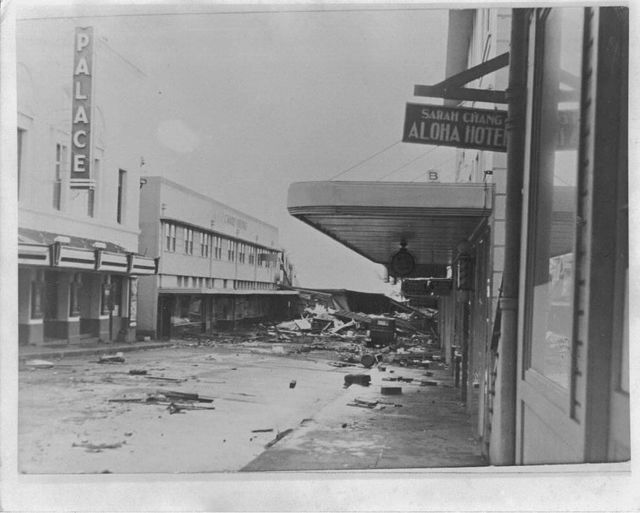The New Palace Theater was like no theater Hilo had ever seen.
The Empire, right across the street, and the Gaiety were both impressive, but the New Palace became the grandest, most luxurious theater in Hilo.
Adam C. Baker, owner-manager of the Gaiety, had dreamt for years of opening his own theater. On Oct. 25, 1924, Honolulu architect Ralph A. Fishbourne of Davis &Fishbourne came to Hilo to design the building. Construction bids were opened on Oct. 29, and contractor S.Z. Kawasaki won the contract of $45,000 (excluding electrical work). Ground was broken Nov. 12, and work began the next day, with completion anticipated by April 1925. The New Palace would be a two-story concrete building in the Beaux Arts style.
It took months longer than expected, but the New Palace stood ready to open in October 1925. Its most notable feature was a stadium-seating arrangement, which offered attendees unobstructed views throughout the auditorium.
Bailey Furniture of Honolulu furnished the theater’s interior. Hilo Iron Works equipped the New Palace with Hilo’s first fire escapes (one on either side of the building) and provided its reinforcing steel. Hawaii Planing Mill furnished all lumber and mill work, and the Hilo Electric Light Co. installed electrical wiring. For the projection booth, a pair of Powers “6B” projectors were brought in, along with a Powers type-E spotlight, and a Powers dissolving stereopticon.
On Oct. 26, 1925, at 6:30 p.m., the New Palace opened its doors to an eager crowd, showing its first movie at 7:30, “Don Q: Son of Zorro,” starring Douglas Fairbanks. Also shown were the short films “The Clodhopper” and “Traps and Troubles.”
An editorial in the next day’s Tribune-Herald proclaimed the town’s enthusiasm: “Metropolitan in every respect! … The new theater is an artistic piece of work. … It would do credit to any city for it has been conceived with an absolute honesty of purpose and with a strict attention to detail which has excluded, absolutely, any element of cheapness.”
By the late 1920s, the New Palace tentatively decided to join the “talkie” revolution. On March 22, 1929, in announcing the order of a $37,500 Robert Morgan philharmonic unit organ, Baker added that he would eventually feature talkies, “the next improvement for my theater.”
In mid-August 1929, with blueprints for an RCA Photophone in hand, Baker said, “It won’t be long before the New Palace theater will be giving the people the latest in talkies.” The new RCA projectors were installed in the New Palace and at the Empire in late September. The Empire was first to exhibit a talkie, “The Voice of the City,” in Hilo on Oct. 9, 1929. The New Palace’s first talkie, shown on Oct. 16, was “Mary Pickford’s Coquette” (incidentally, it was Pickford’s talkie debut). Management of the two theaters decided to take turns exhibiting silent and talkie movies.
In early January 1931, Consolidated Amusement acquired the New Palace for $158,000. The theater closed for renovation after the evening’s final showing on Jan. 6, and reopened under Consolidated management on Jan. 25 with the Harold Lloyd comedy “Feet First.”
Baker continued on as the New Palace’s assistant manager, but retired on Jan. 9, 1932, to travel. He was succeeded that day by Warren F. Stevens. A new booking schedule offered moviegoers four complete program changes weekly. By Dec. 10, 1937, the Palace became not only the first theater, but the first building on the island to be fully air-conditioned when W.A. Ramsay Ltd., installed a Carrier system. The Palace would close for renovation once more on April 25, 1940, after that night’s showing of “All Women Have Secrets” (the movie debut of Jeanne Cagney, younger sister of James). It reopened on May 26, 1940.
The Empire quietly closed May 25, just as the Gaiety had shut its doors on the eve of the New Palace’s opening 15 years prior. In a month’s time, the Hilo Theater opened to great fanfare on April 26 and “succeeded the Palace as the Big Island’s number one show place” as a May 28 editorial said.
But the Palace now had a “long tradition of laughter, tears and thrills” where generations “fondly regarded (it) as a home that has been lived in happily.” The Palace also adopted the Empire’s lower ticket prices and incorporated Japanese and Filipino movies into its schedule.
Despite surviving two tsunamis, the Palace would face its greatest competition 40 years later, when the Waiakea Theaters, billed as the island’s first tri-plex cinema, opened on Aug. 28, 1980. Shifting to a weekend-only schedule of B-movies, the Palace would close quietly on July 19, 1981, after a 9:45 showing of “Fists of Bruce Lee.”
Throughout the ‘80s, the theater was used as a storehouse, but efforts mounted later in the decade to preserve the Palace and reopen it as a performing arts center.
In 1990, the building was acquired from Consolidated, and structural repairs were undertaken. An application dated Nov. 29, 1989, to place the theater on the National Register of Historic Places was accepted May 11, 1993.
Years of fundraising and repairs culminated in the Palace’s grand reopening on Nov. 13, 1998, as a venue for the Hawaii International Film Festival, with film critic Roger Ebert as guest of honor.
Fundraising and repairs continue to this day, and the 90-year-old theater remains one of the Big Island’s premier venues for independent films, concerts and other live performances.
Brandon Haleamau, who writes the “This Day in History” column for the Tribune-Herald, complied this story using newspaper archives.






